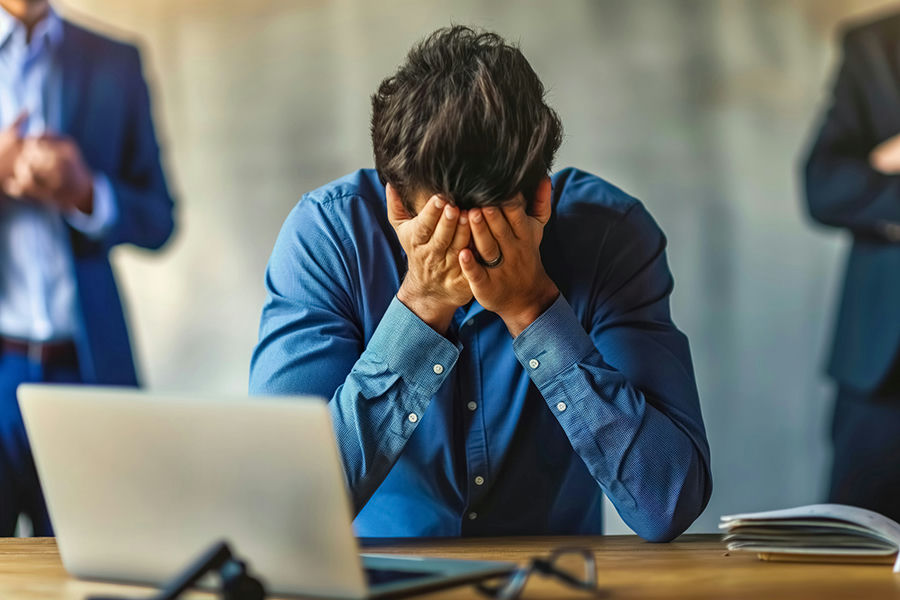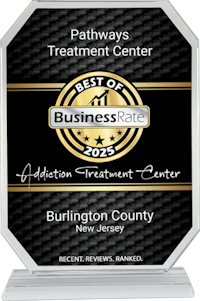Marijuana Addiction Treatment in Burlington, New Jersey
Many people have questions about marijuana, especially as its use becomes more common. Some individuals use marijuana occasionally, while others may find it difficult to stop even when they want to. Understanding how marijuana can affect the brain and daily life is important for anyone who is curious about cannabis use or seeking support for themselves or a loved one.
At Pathways Treatment Center, we see a growing number of individuals in New Jersey looking for answers about marijuana addiction treatment. Our team provides compassionate care and evidence-based programs, such as addiction therapy services, designed for each person’s needs, including cannabis addiction treatment. This article explains what marijuana addiction is, how it is recognized, and how recovery is supported.
Understanding Marijuana Addiction
Cannabis use disorder (CUD) is the clinical term for marijuana addiction. It differs from casual or occasional use. In CUD, a person continues using marijuana even when it causes problems in their life, such as difficulty at school, work, or in relationships.
Marijuana affects the brain by interacting with the endocannabinoid system, which controls mood, memory, and reward. Regular or heavy marijuana use can change how the brain’s reward system works. Over time, this can make it harder for a person to feel pleasure or motivation without using marijuana, which is often part of the cycle of addiction.
According to recent research, about 1 in 10 people who use marijuana will develop cannabis use disorder. Among those who start using in their teens, the risk rises to about 1 in 6. In the United States, millions of people meet the criteria for CUD, showing that marijuana addiction is a real medical condition.
Recovery from marijuana addiction is possible. Marijuana treatment and cannabis addiction treatment are available. Pathways Treatment Center offers programs to help people understand their relationship with marijuana and develop new ways to live without relying on it.
Key Signs of Pot Addiction
- Tolerance: Using higher amounts of marijuana or pot to feel the same effects that were once achieved with less.
- Withdrawal symptoms: Experiencing irritability, trouble sleeping, or decreased appetite when marijuana is not used.
- Loss of control: Attempting to cut down or stop using marijuana but being unable to do so.
- Neglecting responsibilities: Having issues at work, school, or home because of marijuana use.
- Continued use despite problems: Continuing to use marijuana even when it causes conflicts in relationships or leads to legal trouble.
- Craving: Having strong urges or a persistent desire to use marijuana.
These signs may indicate pot addiction and can be present in different combinations for different individuals.
Effects and Risks of Cannabis Abuse
Cannabis abuse can affect the body and mind in both the short term and the long term. These effects may become more noticeable as use increases or continues over time. Cannabis abuse treatment often addresses both immediate symptoms and longer-lasting consequences, which can be provided in an intensive outpatient program.
Short-term effects:
- Impaired memory and concentration: Difficulty focusing or remembering recent events may occur after using marijuana.
- Coordination problems: Movement and balance can be disrupted, increasing the risk of accidents.
- Increased heart rate: Heart rate may rise soon after marijuana use, sometimes lasting for several hours.
- Anxiety or paranoia: Feelings of nervousness or mistrust can develop, especially with higher doses.
Long-term risks:
- Cognitive impairment: Ongoing marijuana use may contribute to problems with thinking, learning, and remembering.
- Respiratory problems (if smoking): Coughing, lung irritation, and other breathing issues may develop when marijuana is smoked.
- Mental health complications: Regular use has been linked to higher rates of depression, anxiety, and other mental health conditions.
- Educational and career setbacks: Persistent cannabis abuse can lead to poor performance at school or work, and may limit future opportunities.
Barriers That Delay Weed Addiction Treatment
Several factors can prevent people from seeking help for weed addiction. These barriers are common and can affect people of all ages and backgrounds.
One major barrier is the stigma around marijuana addiction. Many people feel embarrassed or ashamed to admit they have a problem with marijuana, which can make it difficult to reach out for help for weed addiction. This stigma is often reinforced by friends, family, or the media, leading people to hide their struggles.
Another barrier is the belief that marijuana is not addictive. Some people think marijuana is harmless or less serious than other substances, so they may not recognize when use becomes a problem. This belief can delay treatment or prevent people from seeing the value in cannabis addiction treatment.
Fear of legal consequences is also a concern for some individuals. People who use marijuana illegally may worry about getting into trouble with the law if they ask for help, even though treatment centers provide confidential services.
A lack of awareness about treatment options is another obstacle. Many people do not know that marijuana treatment and support programs exist. This can cause them to feel alone or unsure about where to turn for help.
Cost and insurance concerns may also delay seeking help for weed addiction. Some people worry about how to pay for treatment or whether their insurance will cover it, which can keep them from exploring available resources.
How to Treat Weed and Manage Withdrawal
Treating weed addiction often begins with stopping use and managing withdrawal symptoms. The process can be uncomfortable, but the steps below outline what happens and how to get support.
Withdrawal from marijuana can cause both physical and mental symptoms. These symptoms usually appear within the first week after stopping use and may last up to two weeks.
- Irritability and mood changes often begin soon after stopping and tend to peak during the first week.
- Sleep disturbances, including trouble falling asleep and vivid dreams, are common.
- Decreased appetite and weight loss may occur, especially in the early days.
- Physical symptoms can include headaches or sweating.
These symptoms are temporary and usually ease as the body adjusts.
Support during early recovery can come from family, friends, or professionals. Talking with people who understand the process can help manage stress and keep motivation strong. Professional options include counselors, therapists, and support groups focused on treatment for weed addiction.
Medical guidance can be helpful, especially if withdrawal symptoms are severe or interfere with daily life. Doctors and addiction specialists can monitor symptoms, suggest ways to manage discomfort, and provide safe treatment for weed addiction. Medical supervision is especially important for those with other health conditions or co-occurring mental health issues.


Effective Ganja Addiction Treatment Methods
Several evidence-based approaches are used in ganja addiction treatment to help people make meaningful changes in their relationship with marijuana. These treatments for marijuana addiction are designed to address both the mental and behavioral aspects of THC addiction.
Cognitive Behavioral Therapy (CBT) is a form of talk therapy. In CBT for addiction in New Jersey, individuals work with a therapist to identify patterns in their thoughts and behaviors that lead to marijuana use. The therapy teaches practical techniques for recognizing triggers—situations or feelings that increase cravings—and developing strategies to manage or avoid them.
Motivational Interviewing is a counseling method. In this approach, counselors use open-ended questions and reflective listening to help people explore their feelings about marijuana use. The goal of motivational interviewing is to support individuals in finding their own reasons for wanting to change their behavior and to build confidence in making those changes.
Contingency Management is a reward-based system used in THC addiction treatment. Participants receive incentives, such as vouchers or small prizes, when they reach specific goals like passing a drug test or attending therapy sessions. This structure helps reinforce positive choices and encourages ongoing participation in treatment.
Family or group counseling includes more than one person in treatment sessions. Family counseling brings together loved ones to address communication, set boundaries, and support recovery, often as part of family therapy for addiction. Group counseling connects people who are facing similar challenges, allowing them to share experiences, offer support, and hold each other accountable during the recovery process.
Recovery Options for Cannabis Addiction
Treatment options for weed, dagga addiction treatment, and treatment for cannabis include several levels of care. Each level provides a different environment, structure, and amount of support. The main types are outpatient, intensive outpatient, and inpatient (residential) programs.
The table below compares these recovery options:
| Program Type | Living Situation | Support Level | Time Commitment | Typical Duration | What to Expect
|
| Outpatient | Live at home | Low to moderate | 1-3 sessions/week | Weeks to months | Regular therapy sessions, flexible schedule |
| Intensive Outpatient (IOP) | Live at home | Moderate to high | 3-5 sessions/week | 1-3 months | More frequent therapy, group and individual |
| Inpatient/Residential | Live at treatment facility | 24/7 supervision | Full-time | 28+ days to several months | Structured days, constant support, group and individual therapy |
Outpatient programs allow individuals to continue their daily activities while attending therapy. Intensive outpatient programs offer more support and structure, often including both group and individual therapy, but do not require living away from home. Inpatient or residential programs provide constant supervision in a structured environment, which removes individuals from triggers and daily stressors.
The best option depends on how severe the cannabis use is, whether there are other mental health needs, and what level of support is available at home. Some individuals move between levels of care as they progress in recovery, such as a partial hospitalization program or outpatient support. Each program may offer dagga addiction treatment and evidence-based therapies for the treatment of cannabis use disorder.
Choosing the Best Treatment for Marijuana
Selecting a program for treatment for marijuana addiction involves several key considerations. People have different backgrounds, health needs, and goals, so a one-size-fits-all approach does not work for marijuana addiction treatment or pot addiction treatment.
- Evidence-based approaches: Programs that use therapies supported by research, such as cognitive behavioral therapy, motivational interviewing, or contingency management, are more likely to address the underlying causes and patterns of substance use.
- Qualified staff: Treatment centers usually have licensed counselors, addiction specialists, and healthcare professionals. These individuals are trained to guide people through the process of recovery and address both substance use and any related mental health concerns.
- Individualized treatment plans: Programs that offer assessments and tailor plans to each person’s needs can adjust care as progress is made or as new challenges appear.
- Insurance coverage: Understanding what insurance covers and what costs may be involved helps people plan for treatment. Some centers accept many types of insurance, while others may offer payment plans or sliding-scale fees.
- Location and accessibility: The location of a treatment center and how easy it is to get there can affect ongoing participation. Some people prefer to stay close to home, while others may look for programs farther away for privacy or a fresh start.
Questions to ask when considering a treatment for marijuana addiction program include: What therapies are used? Are the staff licensed and experienced with marijuana addiction treatment? How is each treatment plan created and updated? What are the costs, and what forms of insurance are accepted? How far is the center from home, and what transportation options are available?
Frequently Asked Questions About Marijuana Addiction Treatment
Addiction is not only about how often someone uses marijuana, but whether they experience loss of control or continue to use it despite negative effects on their life. A person can show signs of addiction if their use leads to problems, even if it happens infrequently.
During a first treatment appointment, a clinician will usually ask questions about marijuana use, health history, and daily routines to better understand the situation. This assessment helps create a treatment plan that matches the individual’s needs.
The length of marijuana addiction treatment varies, but many people participate in treatment and recovery support for several months. Recovery is considered an ongoing process, and some people continue with support groups or counseling after formal treatment ends.
There are currently no FDA-approved medications designed specifically for marijuana addiction. However, doctors may prescribe medications to help manage certain withdrawal symptoms, such as trouble sleeping or mood changes.
Many insurance plans include coverage for addiction treatment services. It is recommended to contact the treatment center or your insurance provider to verify what is covered under your specific plan.

Moving Forward with Cannabis Addiction Treatment
Ongoing support is a core part of cannabis addiction treatment and weed addiction treatment. After initial treatment, many people find it helpful to stay connected with a counselor, group, or recovery community to help manage triggers and prevent relapse, often by creating a relapse prevention plan. This support can include regular therapy sessions, check-ins with a treatment team, or participation in peer groups.
Building new routines is important in long-term recovery. Many individuals find that adopting healthier habits—such as regular exercise, improved sleep routines, and new hobbies—can help fill the time previously spent using marijuana. Setting realistic goals and tracking progress can make it easier to notice improvements and maintain motivation.
Resources for continued recovery are available in many forms. Support groups, online communities, educational materials, and professional counseling services offer ongoing guidance. The Substance Abuse and Mental Health Services Administration (SAMHSA) provides information and a helpline for individuals and families seeking support with substance use issues.
Pathways Treatment Center offers a comprehensive approach to cannabis addiction treatment. Programs are designed to support each stage of recovery, from early withdrawal through long-term relapse prevention, and include access to therapy, education, and community resources.
Ready to start your recovery journey? Contact Pathways Treatment Center today to learn about our personalized marijuana addiction treatment programs. Contact us to start your path to recovery


